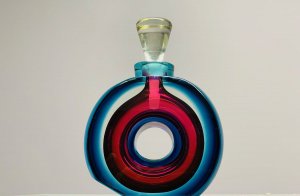A new fragrance is a fragile dream that is measured and nurtured by an amalgam of science, skills and knowledge that transcend the mere blending of diverse ingredients. Creating a scent represents the fantasy, fusion and vagaries of the human imagination and the tender capture of the essence of an olfactory narrative.
As is always the case with any art form, ideas for new fragrances are more plentiful than the time required to complete them. Seizing those ideas and transforming them into a workable concept for perfume formulation requires direction and structure both of which can best be achieved via the use of fragrance briefs.

What Is A Fragrance Brief?
A fragrance brief serves as a crucial blueprint in the successful development of any new perfume. It is meant to relay to an experienced perfumer a particular vision for a specific scent.
Although they can differ greatly both in substance and in form, the ideal format for a brief is a balanced middle ground where the most vital aspects of a fragrance are clearly communicated, while at the same time, enough creative room for a perfumer’s artistic interpretation remains. Vocabulary often serves as a stumbling block to effective communication when it comes to describing envisioned scents.
In the words of Arnold Zlotnik (pictured below), President and CEO of Alpha Aromatics, “Everything in business begins with a workable plan. In the case of a new fragrance this entails: establishing product definition, marketing niche and strategies and profit/loss projections. Product definition involves fragrance specifications concerning whether a new perfume should become available as a single scent in several varied formats, such as: cologne, body lotion, soaps, detergent or other cleaning products or just one type of product, but in diverse scents. Researching consumer trends can be tedious, but it is part of a process that is absolutely necessary in order to determine which demographics the new fragrance will attract and in which product form.”

There Can Be Issues With Fragrance Brief Varieties
The fragrance briefs perfume houses receive every day range from offering little guidance and direction or too much of the same. To request a fragrance that smells like the sea or the color, blue, for example, can be a nightmare to the perfumer because it offers no details and forces the employment of guesswork.
Conversely, some companies submit briefs that are so detailed that that there is no room for creativity on the part of the perfumer, which is vital to the design of an effective scent.
A good fragrance brief gives the work direction and purpose. It not only includes notes for designing the olfactory narrative, it also contains relevant inspirational bits of information to suggest the formulation of scent ideas. Without a coherent brief, the nascent fragrance lacks structure and point of view. The brief can be compared to a musical score for a conductor, who then uses it to set the tempo and mood of the orchestra.
The conveyance of requirements for a new fragrance is an intricate process, as it demands an understanding of and respect for the power of words. People differ in language competency and vocabulary usage, and yet they have to communicate and understand each other.
It is the precise sequence of words describing the character of an ethereal fragrance that makes is possible for a perfumer to comprehend both its olfactory impact and ultimate goal. It serves as a path to the consistent and effective editing of more precise notes.

Explore our guide to launching a perfume line!
The crafting and executing of a brief requires a practiced, almost all-seeing eye because the writer must be aware of both a proposed olfactory profile and an impact and connection with a target audience with a tale they can identify with.
The brief explains who the perfume should appeal to and why, what the scent should evoke to the smeller and what forms the fragrance will take. It also explains where and for how long the scent will be sold. The brief is mailed to fragrance houses that employ perfumers to both design and write the formulas.
A manufacturer stockpiles thousands of diverse perfume ingredients. They also have a staff of chemists who can pinpoint the molecules in an unknown liquid using an analytical technique called gas chromatography mass spectrometry.
There Are Two Types Of Fragrance Briefs
The manufacturer’s brief is sent to fragrance houses along with an initial request for submissions. It is assembled by the marketing team of a brand or company, but is rarely composed by someone with specific education on the art of perfumery. It usually includes: a fragrance profile, the estimated cost of raw materials, a development schedule and packaging and design concepts.

Creative briefs, which are also as known as Blue Sky briefs, are simple, short and concise and meant to inspire both the perfumer and perspective clients. They are strictly internal house projects and they have no specific client in mind. They are unifying document that should offer a 360° technical picture of the end product and be highly detailed.
It must mention the characteristics and the values the fragrance is expected to convey. This grants the perfumer creative carte blanche in terms of inspiration for fragrance development.
Fragrance Briefs Are Sometimes Comprised Of Images Only
According to Roger Howell, Vice President and chef perfumer at Alpha Aromatics, “A lot of briefs are done with just pictures. The perfumer has to look at the images and channel the picture with the desired scent. Sometimes it’s easy, and at other times it can be complicated (based on interpretation). The goal is to draw in the consumer from images and ads without smelling, and hoping the scent will eventually convey the particular story the pictures are telling.”
Tim George, Vice President of New Account Development At Alpha Aromatics believes that creativity flows from more than one source. He states: “Pictures (aka mood boards) help to get the perfumer in a mood when creating the fragrance, which is a little difficult, as there is less description of what the customer is looking to achieve.”

Tim George, Bryan Zlotnik and Roger Howell at the 2019 ISSA show
Mood boards are themselves works of art exemplifying to the penultimate degree the blend of artistic mastery and expression with subliminal advertising. The mood board below epitomizes this concept as illustrated in the picture brief for a new fragrance. A whirl of delicate femininity is suggested to the perfumer by fleeting, floral pastel impressions.

Conversely, a mood board for male fragrances are generally conceptualized with images that are decidedly more sharp. A bold masculine scent could be imagined with accoutrements of the modern male including time pieces, accessories and leather.
Steps To Consider When Composing A Fragrance Brief
The following are some suggested steps to aid in the composition of an effective fragrance brief, which must offer a coherent structure and give the project a clear perspective.
Determine How You Want Your Fragrance To Smell
One question that adds focus for the development of this first step is to ask oneself: how do I want this fragrance to smell? This could require some thought, as it may be a brand new fragrance, a favored combination of scents, a new twist on an existing scent or the replication of a long lost perfume. Focusing on this singular aspect will help relate to a perfumer the specific story you want your scent to tell.
This section can be a brain-storming moment. Questions can and should include: What are the outstanding key notes and materials? .Does the fragrance belong to a particular olfactive family? What has inspired the scent? Are there flavors involved and how can the projected textures be described? Are there colors and sounds that come to mind at the thought of this fragrance?

What Is the Consumer Target Of The New Fragrance?
This aspect of a fragrance brief addresses the question of who will wear the new scent. Will it appeal to everyone or is it targeted specifically for men, women or certain age groups? This requires market knowledge and research as it includes understanding consumer usage, attitudes and the needs related to a specific scent. By way of example, in the case of personal care products, here is a list of the top essential oils women statistically prefer in personal care products.
Consider The End Product Package Design
Whether fair or not, consumers do tend to make judgements based on how a product looks. A package design of any kind reveals much about a company’s specific brand and how it will fare in the retail market place. One rule of thumb is that the ‘catchier’ and more unique a design is, the more audiences it will attract.

At the same time, good packaging sets products apart from others of their ilk. When consumers recognize a brand from its packaging, it creates an emotional consistency and strengthens brand identity, which makes it easier to stand out from other competing brands. Packaging must also mirror the brand message. Sustainable materials reflect the promise of an eco-friendly product and luxury items require the employment of high-end packaging resources.
Determine The Technical Aspects Of Your Fragrance
While this may not be the most creative or interesting facet of the fragrance brief, it is essential to its overall character. Features should include: an olfactory profile, dosage, expected performances, restrictions and regulatory requirements.
In addition, it should also include: a strategy for product release, distribution channels, and the proposed wholesale or retail format of the launch of the new scent. Finally, to insure the shortest time-to-market, there should be mention of both the timeline and deadline of the fragrance project.
Clarify Marketing Aspects For Your Product
The fragrance brief is a highly effective marketing tool, but creators must construct it carefully. This means researching how a new fragrance will measure up to existing products in terms of character, quality, materials and brand image. It also requires an understanding of tone and language and its impact on target audiences.
The most important factor in an advertising campaign is to tap into the psychological link of a new fragrance with an abstract idea such as: femininity, masculinity or passion. Words like cheeky, traditional, casual and trendy help to clarify the essence and marketing direction of a fragrance. Also, include what type of imagery might fare well in an ad for this new scent.
There is no understating the importance of a comprehensive and concise fragrance brief for putting the concept of a new perfume into marketable words. It is crucial to the development and successful launch of the scent into the market place . It presents an opportunity to transmit the “big picture” to master perfumers who can then proceed with the formulation process.
Alpha Aromatics and Fragrance Briefs
Our perfumers and chemists at Alpha Aromatics live, know, respect and understand both the language and the power of perfume. We are an international leader within the perfume industry and receive a myriad of fragrance briefs every day of the year Our researchers and chemists have been producing fine perfumes for decades, and when it comes to translating any company’s olfactory vision into fragrance terms that will attract and engage consumers, our expertise is unparalleled.

Our team of fragrance experts work closely with clients to help them properly define their briefs by showing them how to combine creative finesse with a deep level of technical knowledge and innovation. This occurs at our 85,000-square-foot Technology Center, which is situated in suburban Pittsburgh and lies at the heart of our constant state of innovation within the world of industrial science.
Roger Howell, Vice president of Alpha Aromatics, and his team of perfumery experts continually track industry fragrance trends and those on the horizon to deliver targeted solutions for a wide spectrum of industries seeking scent design. Even more, our laboratories are equipped with the best state-of-the-art tools that money can buy. These include: gas chromatography, mass spectrometry, headspace analysis, distillation, extraction and quality control technology.
In Conclusion
So follow the above process for creating your fragrance brief, and when you’re ready, call our teams today and let our expert perfumers transform your company’s vision for a new scent into a fragrant reality.
Final thought on perfume: Perfume has the power to persuade that is more convincing than words, than appearances, sentiment or willpower. You cannot say no to the persuasive Power of Perfume… –Patrick Suskind
What is a fragrance brief?
A fragrance brief serves as a crucial blueprint in the successful development of any new perfume. It is meant to relay to an experienced perfumer a particular vision for a specific scent.
What are the two types of fragrance briefs?
The two types of fragrance briefs are a manufacturers’ brief and a creative brief, otherwise known as a blue sky brief. Fragrance briefs are also sometimes comprised of images only.
What are the key steps to creating a fragrance brief?
1) Determine how you want your fragrance or fragrances to smell
2) Designate the consumer target for your fragrance
3) Consider the end product packeting design
4) Determine the technical aspects of your fragrance
5) Clarify marketing aspects for your product or product line
Photo Credits: Pixabay
 alpha aromatics®
alpha aromatics®